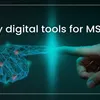10 ways MSMEs can ensure cash flow in hard times
Here’s how you can handle operating cash flow, which involves the management of cash inflow and outflow related to business operations.
“Revenue is vanity. Profit is sanity. Cash is reality.” — is an adage that is true any time but more true during difficult times.
Cash flow management is the process of analysing, monitoring, controlling, and optimising the cash inflow and outflow of your business.
Cash flow is highly crucial for any business, but more so for small businesses. They need to avoid all cash flow shortages that could disrupt their businesses.
Here, we will discuss operating cash flow, which involves the management of cash inflow and outflow related to business operations.
Be agile on receivable
The sales process, including receivable, is arguably the most important element in a cash flow cycle. The management of receivable starts from accurate and timely invoicing in an agile way to following up payments with customers and keeping track of outstanding invoices.
Companies tend to get easy about receivables during normal and booming times, which leads to cash flow struggles, disrupting business, supply chains, and delaying supplier payments.
It is important to identify companies that may be changing their payment policies and practices and work with them. Extending cash discounts for early payment is a tool that can be employed to expedite the payments.
To facilitate all the above actions, you need to implement ERP and analytics to get relevant data that will help in effectively managing the receivables and eliminating the bad debts. The objective of the collection team must be to minimise losses and liquidate the cash blocked in receivables as fast as possible.
Customer credit checks and credit control are other methods to avoid delays, but proper thought must be given to it when it comes to MSMEs, especially if the customer is a large enterprise.
Be cautious and vigilant with payable
Procurement function, including payable, involves getting quality material or services at the best price, of the economic quantity, at the right time.
Getting the payment terms aligned with the one agreed with your customers is an important aspect that can make your cash flow smooth. If that is not so, you should renegotiate with your suppliers, especially during difficult times.
Some companies may arbitrarily decide to delay the payments to their suppliers, especially when money is stuck with inventory. This might put pressure on the cash flow of your suppliers, which, in turn, could lead to late deliveries, quality problems, and strained supply relationships.
You should work with your suppliers for solutions that would help you both.
Manage inventory well
Inventory includes goods procured for selling, materials kept for manufacturing, and work-in-process The challenge is to maintain an optimal inventory that will not disrupt the business, and not block too much of your cash.
Balancing the demands for sufficient inventory and managing cash flow may not be a cakewalk for SMBs. If you want to manage your inventory, operations, and cash flow in tandem, it calls for fundamental improvements in supply chain inventory visibility, demand planning, inventory policies, production planning and scheduling, lead-time, etc.
You should also explore the possibilities of inventory financing option, which is comparatively easy to get than other lines of credit.

Lease or buy
In finance, buy or lease is an important decision-making option. Leasing, of course, is expensive because of the interest and profit components factored in it.
However, you should evaluate the two options, considering the present value of down payment and the lease payments that are to be made over many years. Money that is not invested upfront can fetch an alternative return.
Moreover, the lease option does away with a big investment in one go, which, in turn, eases your cash flow. The Anything-as-a-Service sector has improvised the leasing method to help you avail of equipment, hardware, and services online on a pay-as-you-go or on-demand or subscription model.
Leverage MSME government schemes
Many government schemes are useful for MSMEs to tide over cash shortages.
These schemes include the Emergency Credit Line Guarantee Scheme (ECLGS) that helps MSMEs mitigate pandemic driven issues; collateral-free credits under the Credit Guarantee Scheme; protection against delayed payments that mandate timely payment to MSMEs; and trade receivables discounting system (TReDS), among others.
You should explore and identify the most relevant schemes that can address the cash flow pains of your company.
Focus on the cash-to-cash conversion cycle
Cash-to-cash conversion refers to working capital management. Companies normally focus on profit and loss–growing the top line while managing the bottom line and tend to neglect cash management till it disrupts the business.
The efficient management of the three elements of the supply chain working capital — payables, receivables, and inventory — in a coordinated manner is crucial for an ideal cash flow, which can support the sustenance and continuity of your business.
Revisit your variable and fixed costs
Identify the variable costs that can be reduced or eliminated without disrupting the sustainability and continuity of the business. Managing variable costs is quicker and easier than fixed costs as it involves strategic decisions.
More importantly, you should evaluate ways to swap fixed costs for variable costs. This releases cash that would be spent on fixed costs for managing critical business requirements.
You should also consider what capital investments are required immediately to sustain and continue the business. You cannot disregard the need for investments that will help you grow and scale.
Consider alternate or non-traditional revenue streams
If the difficult times are slowing down your revenue streams, consider ways you could temporarily or permanently replace that revenue model. For example, if your primary markets are international, pivot your focus to domestic markets.
Do you think differently about how your assets can be used to generate alternate revenue sources? For example, we have seen many companies producing items or providing services specifically needed for the COVID-19 while it was not their core business till then.
Use electronic payments
The ability of MSMEs to accept electronic payments will expedite collection against the conventional methods of cheques and bank transfers, which will collectively make a substantial difference in the health of your cash flow.

Adopt digital technologies
MSMEs lag in the adoption of technology, and this impacts their productivity and efficiency in the entire business cycle.
While emerging technologies, including automation, helps reduce costs and bring agility in processes to retain customers, SaaS converts Capex to Opex and ERP, CRM, and data analytics help manage operations and business efficiently.
Bottom line
These 10 tips are not an exhaustive list of tools to manage cash flow in hard times. You should evaluate the situation and nature of the cash problem of your business specifically to choose the right combination of solutions for them.
Edited by Suman Singh
(Disclaimer: The views and opinions expressed in this article are those of the author and do not necessarily reflect the views of YourStory.)









